ESP DACIA LODGY 2012 1.G User Guide
[x] Cancel search | Manufacturer: DACIA, Model Year: 2012, Model line: LODGY, Model: DACIA LODGY 2012 1.GPages: 196, PDF Size: 5.73 MB
Page 72 of 196

Downloaded from www.Manualslib.com manuals search engine driving ................................................... (up to the end of the DU)
special features of diesel versions ........(up to the end of the DU)
filter particle filter .................................... (up to the end of the DU)
2.5
ENG_UD24431_1
Particularités des versions diesel (X92 - Renault)
ENG_NU_975-3_X92_Dacia_2
Special features of diesel versions
SPECIAl fEATURES Of DIESEl vERSIONS
Diesel engine speed
Diesel engines are fitted with an injec -
tion pump which prevents the engine
speed being exceeded irrespective of
the gear selected.
When driving, depending on the fuel
grade used, it is possible that white
smoke may be emitted.
This is due to the exhaust particle filter
being cleaned automatically, and does
not affect the way the vehicle runs.
Running out of fuel
If the tank has been completely
drained, the system must be reprimed
after the tank is refilled: see information
on the “Fuel tank” in section 1 before
restarting the engine.Precautions to be taken in winter
To avoid any faults in icy weather:
– ensure that the battery is always fully
charged,
– always keep the diesel tank rela -
tively full to avoid water vapour con-
densing in it and accumulating at the
bottom of the tank.
Do not park the vehicle or
run the engine in locations
where combustible sub -
stances or materials such
as grass or leaves can come into
contact with a hot exhaust system.
Page 73 of 196
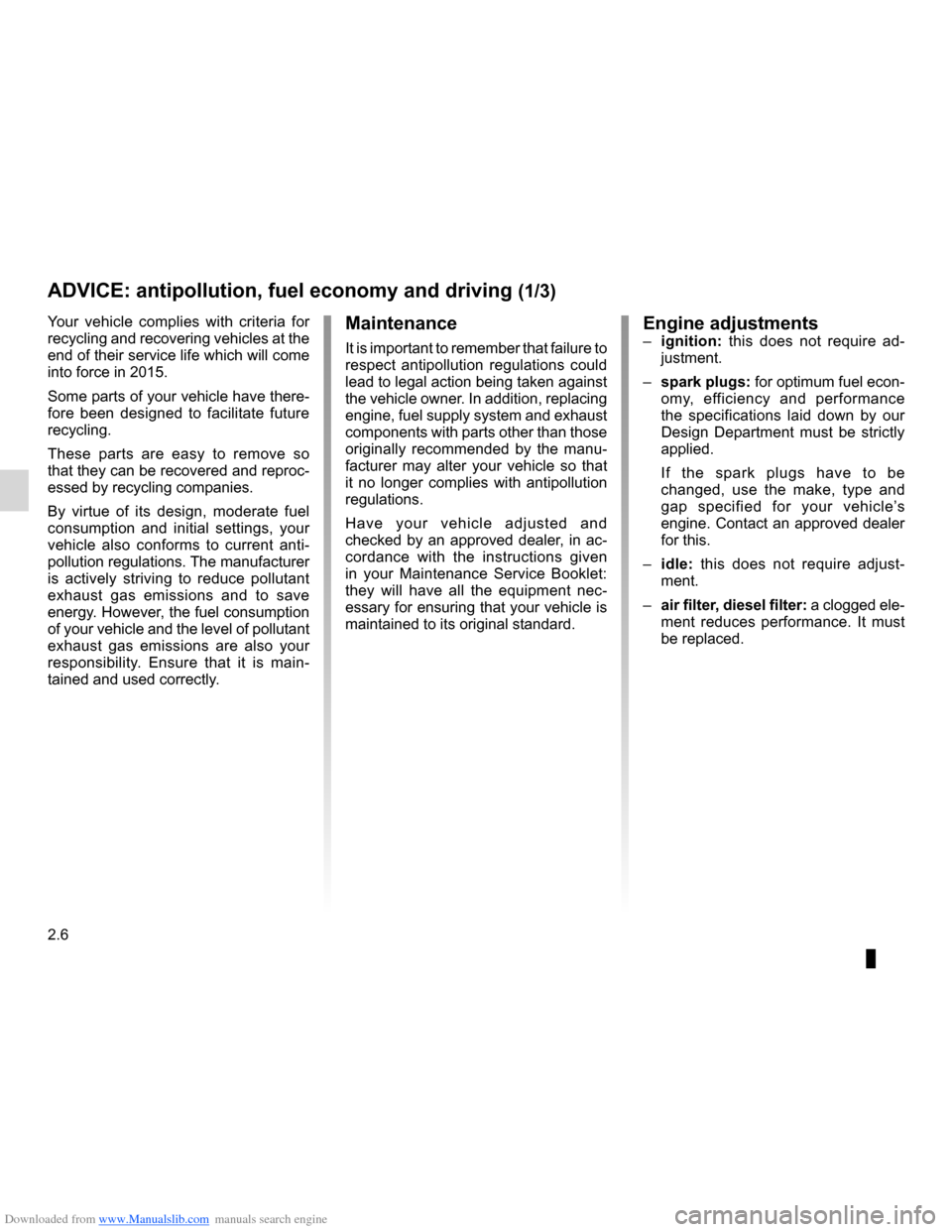
Downloaded from www.Manualslib.com manuals search engine antipollutionadvice ............................................. (up to the end of the DU)
fuel advice on fuel economy .................. (up to the end of the DU)
driving ................................................... (up to the end of the DU)
advice on antipollution .......................... (up to the end of the DU)
practical advice ..................................... (up to the end of the DU)
fuel economy ........................................ (up to the end of the DU)
2.6
ENG_UD19988_2
Conseils antipollution, économies de carburant, conduite (X65 - X65 \
PH5 - Renault)
ENG_NU_975-3_X92_Dacia_2
Jaune NoirNoir texte
Advice: antipollution, fuel economy and driving
ADvICE: antipollution, fuel economy and driving (1/3)
Your vehicle complies with criteria for
recycling and recovering vehicles at the
end of their service life which will come
into force in 2015.
Some parts of your vehicle have there-
fore been designed to facilitate future
recycling.
These parts are easy to remove so
that they can be recovered and reproc-
essed by recycling companies.
By virtue of its design, moderate fuel
consumption and initial settings, your
vehicle also conforms to current anti-
pollution regulations. The manufacturer
is actively striving to reduce pollutant
exhaust gas emissions and to save
energy. However, the fuel consumption
of your vehicle and the level of pollutant
exhaust gas emissions are also your
responsibility. Ensure that it is main -
tained and used correctly.Maintenance
It is important to remember that failure to
respect antipollution regulations could
lead to legal action being taken against
the vehicle owner. In addition, replacing
engine, fuel supply system and exhaust
components with parts other than those
originally recommended by the manu -
facturer may alter your vehicle so that
it no longer complies with antipollution
regulations.
Have your vehicle adjusted and
checked by an approved dealer, in ac-
cordance with the instructions given
in your Maintenance Service Booklet:
they will have all the equipment nec -
essary for ensuring that your vehicle is
maintained to its original standard.
Engine adjustments– ignition: this does not require ad -
justment.
– spark plugs: for optimum fuel econ-
omy, efficiency and performance
the specifications laid down by our
Design Department must be strictly
applied.
If the spark plugs have to be
changed, use the make, type and
gap specified for your vehicle’s
engine. Contact an approved dealer
for this.
– idle: this does not require adjust -
ment.
– air filter, diesel filter: a clogged ele-
ment reduces performance. It must
be replaced.
Page 76 of 196
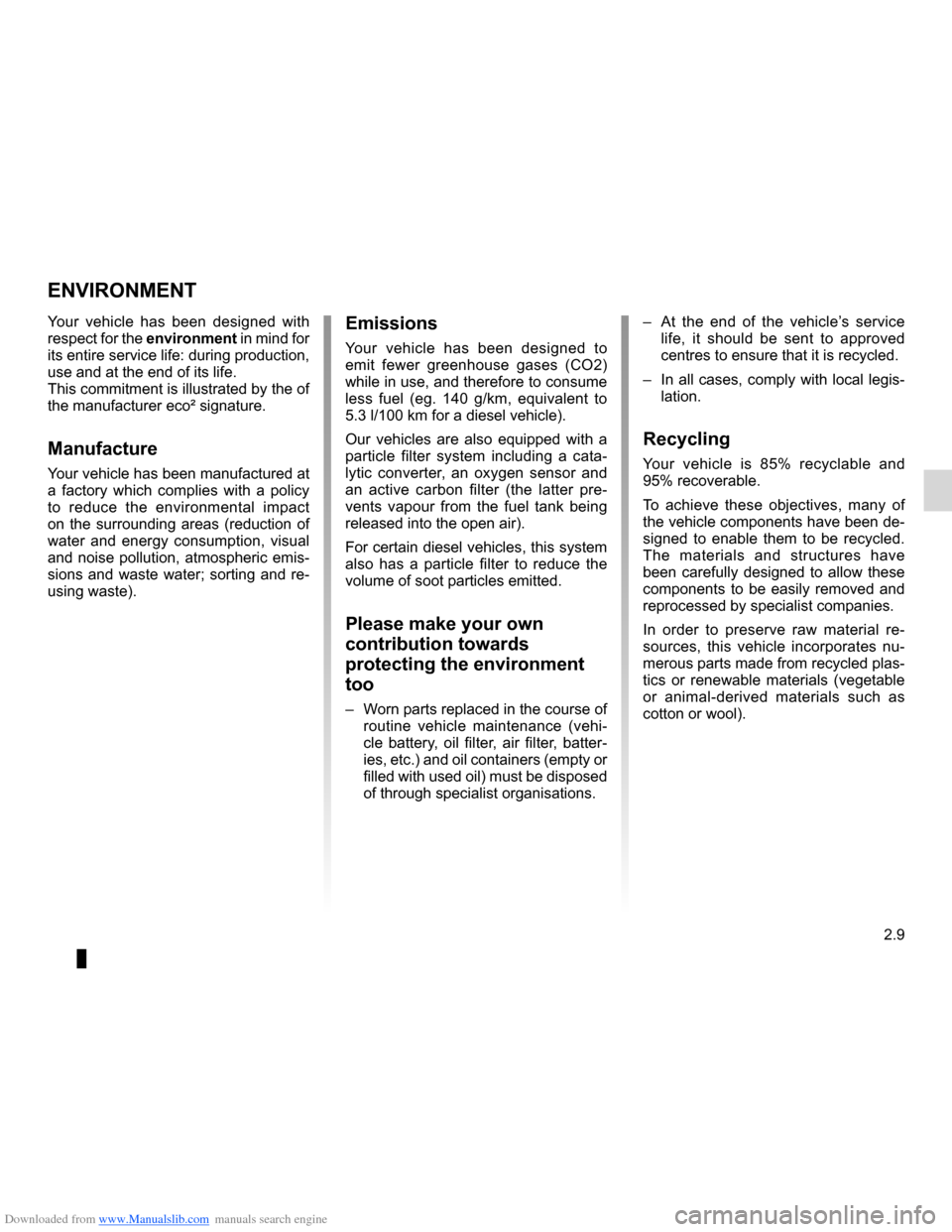
Downloaded from www.Manualslib.com manuals search engine environment .......................................... (up to the end of the DU)
2.9
ENG_UD25716_1
Environnement (sans marque) (X44 - X45 - X77 - X81 - X85 - X90 - X91 \
- X83 - X61 - TEST - X95 - J95 - R95 - F90 Ph2 - X33 - X47 - X43 - X38 - H79 - X62 - X32 -\
X09 -
ENG_NU_975-3_X92_Dacia_2
Environment
ENvIRONMENT
Emissions
Your vehicle has been designed to
emit fewer greenhouse gases (CO2)
while in use, and therefore to consume
less fuel (eg. 140 g/km, equivalent to
5.3 l/100 km for a diesel vehicle).
Our vehicles are also equipped with a
particle filter system including a cata -
lytic converter, an oxygen sensor and
an active carbon filter (the latter pre -
vents vapour from the fuel tank being
released into the open air).
For certain diesel vehicles, this system
also has a particle filter to reduce the
volume of soot particles emitted.
Please make your own
contribution towards
protecting the environment
too
– Worn parts replaced in the course of
routine vehicle maintenance (vehi -
cle battery, oil filter, air filter, batter -
ies, etc.) and oil containers (empty or
filled with used oil) must be disposed
of through specialist organisations. –
At the end of the vehicle’s service
life, it should be sent to approved
centres to ensure that it is recycled.
– In all cases, comply with local legis -
lation.
Recycling
Your vehicle is 85% recyclable and
95% recoverable.
To achieve these objectives, many of
the vehicle components have been de-
signed to enable them to be recycled.
The materials and structures have
been carefully designed to allow these
components to be easily removed and
reprocessed by specialist companies.
In order to preserve raw material re -
sources, this vehicle incorporates nu -
merous parts made from recycled plas-
tics or renewable materials (vegetable
or animal-derived materials such as
cotton or wool).
Your vehicle has been designed with
respect for the
environment in mind for
its entire service life: during production,
use and at the end of its life.
This commitment is illustrated by the of
the manufacturer eco² signature.Manufacture
Your vehicle has been manufactured at
a factory which complies with a policy
to reduce the environmental impact
on the surrounding areas (reduction of
water and energy consumption, visual
and noise pollution, atmospheric emis-
sions and waste water; sorting and re-
using waste).
Page 79 of 196
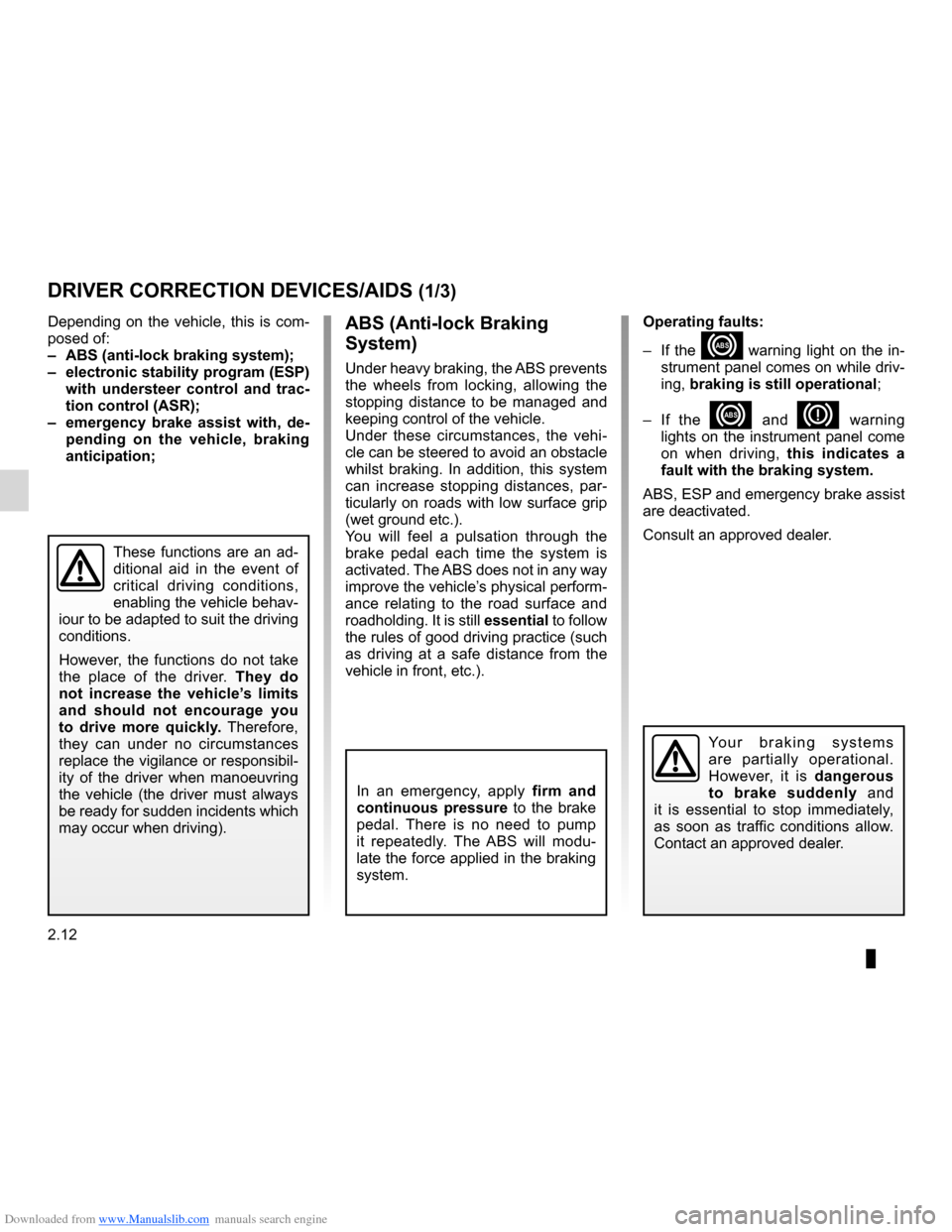
Downloaded from www.Manualslib.com manuals search engine driving ................................................... (up to the end of the DU)
ABS ...................................................... (up to the end of the DU)
anti-lock braking system: ABS ..............(up to the end of the DU)
ASR (traction control) ........................... (up to the end of the DU)
traction control: ASR .............................(up to the end of the DU)
ESP: Electronic Stability Program ........ (up to the end of the DU)
traction control: ASR .............................(up to the end of the DU)
emergency braking ............................... (up to the end of the DU)
Electronic Stability Program: ESP ........ (up to the end of the DU)
2.12
ENG_UD24436_1
Dispositifs de correction et d’assistance à la conduite (X92 - Re\
nault)
ENG_NU_975-3_X92_Dacia_2
Jaune NoirNoir texte
Driver correction devices and aids
DRIvER CORRECTION DEvICES/AIDS (1/3)
ABS (Anti-lock Braking
System)
Under heavy braking, the ABS prevents
the wheels from locking, allowing the
stopping distance to be managed and
keeping control of the vehicle.
Under these circumstances, the vehi -
cle can be steered to avoid an obstacle
whilst braking. In addition, this system
can increase stopping distances, par -
ticularly on roads with low surface grip
(wet ground etc.).
You will feel a pulsation through the
brake pedal each time the system is
activated. The ABS does not in any way
improve the vehicle’s physical perform-
ance relating to the road surface and
roadholding. It is still essential to follow
the rules of good driving practice (such
as driving at a safe distance from the
vehicle in front, etc.). Operating faults:
–
If the
x warning light on the in-
strument panel comes on while driv-
ing, braking is still operational ;
– If the
x and D warning
lights on the instrument panel come
on when driving, this indicates a
fault with the braking system.
ABS, ESP and emergency brake assist
are deactivated.
Consult an approved dealer.
Depending on the vehicle, this is com-
posed of:
– ABS (anti-lock braking system);
– electronic stability program (ESP)
with understeer control and trac -
tion control (ASR);
– emergency brake assist with, de -
pending on the vehicle, braking
anticipation;
In an emergency, apply firm and
continuous pressure to the brake
pedal. There is no need to pump
it repeatedly. The ABS will modu -
late the force applied in the braking
system.
These functions are an ad-
ditional aid in the event of
critical driving conditions,
enabling the vehicle behav -
iour to be adapted to suit the driving
conditions.
However, the functions do not take
the place of the driver. They do
not increase the vehicle’s limits
and should not encourage you
to drive more quickly. Therefore,
they can under no circumstances
replace the vigilance or responsibil -
ity of the driver when manoeuvring
the vehicle (the driver must always
be ready for sudden incidents which
may occur when driving).
Yo u r b r a k i n g s y s t e m s
are partially operational.
However, it is dangerous
to brake suddenly and
it is essential to stop immediately,
as soon as traffic conditions allow.
Contact an approved dealer.
Page 80 of 196

Downloaded from www.Manualslib.com manuals search engine JauneNoirNoir texte
2.13
ENG_UD24436_1
Dispositifs de correction et d’assistance à la conduite (X92 - Re\
nault)
ENG_NU_975-3_X92_Dacia_2
DRIvER CORRECTION DEvICES/AIDS (2/3)
Electronic stability program
(ESP) with understeer control
and traction control (ASR)
Electronic stability control ESC
This system helps you to keep control
of the vehicle in critical driving condi -
tions (avoiding an obstacle, loss of grip
on a bend, etc.).
Operating principle
A sensor in the steering wheel detects
the direction selected by the driver.
Other sensors throughout the vehicle
measure the actual direction.
The system compares driver input to
the actual trajectory of the vehicle and
corrects the trajectory if necessary by
controlling the braking of certain wheels
and/or engine power. In the event that
the system is engaged, indicator light
flashes on the instrument panel. Operating faults
When the system detects an operating
fault, the
and/or warning
lights on the instrument panel come on.
In this case, the ESP and traction con-
trol are deactivated.
Consult an approved dealer.
Understeer control
This system optimises the action of the
ESP in the case of pronounced unders-
teering (loss of front axle grip).
Traction control ASR
This system helps to limit wheelspin of
the drive wheels and to control the ve-
hicle when pulling away accelerating or
decelerating.
Operating principle
Using the wheel sensors, the system
measures and compares the speed of
the drive wheels at all times and slows
down their over-rotation. If a wheel is
starting to slip, the system brakes au
-
tomatically until the drive supplied be -
comes compatible with the level of grip
under the wheel again.
The system also adjusts the engine
speed to the grip available under the
wheels, independently of the pressure
exerted on the accelerator pedal.
Page 81 of 196

Downloaded from www.Manualslib.com manuals search engine emergency brake assist........................(up to the end of the DU)
2.14
ENG_UD24436_1
Dispositifs de correction et d’assistance à la conduite (X92 - Re\
nault)
ENG_NU_975-3_X92_Dacia_2
DRIvER CORRECTION DEvICES/AIDS (3/3)
The traction control ASR offers addi -
tional safety, it is recommended that
you do not drive with the function disa-
bled. Correct this as soon as possible
by pressing switch 1 again.
Note: The function is reactivated auto-
matically when the ignition is switched
on or when a speed of approximately
30 mph (50 km/h) is exceeded.
Emergency brake assist
This is an additional system to ABS
which helps reduce vehicle stopping
distances.
Operating principle
The system detects an emergency
braking situation. In this case, the brak-
ing assistance immediately develops
maximum power and may trigger ABS
regulation.
ABS braking is maintained as long as
the brake pedal is not released.
Hazard warning lights switching on
Depending on the vehicle, these may
light up in the event of sudden decel -
eration.
Operating faults
When the system detects an operating
fault, the warning light
x is dis -
played on the instrument panel.
Consult an approved dealer.
Braking anticipation
Depending on the vehicle, when you
rapidly release the accelerator, the
system anticipates the braking ma -
noeuvre in order to reduce stopping
distances.
Disabling the ASR function
In some situations (driving on very wet
ground: snow, mud, etc. or driving with
snow chains fitted), the system may
reduce the engine output to limit wheel
-
spin. If this is not required, it is possible
to deactivate the function by pressing
switch 1. In this case, the warning light
comes on, on the instrument
panel. This action does not deactivate
the ESP.
1
Page 84 of 196
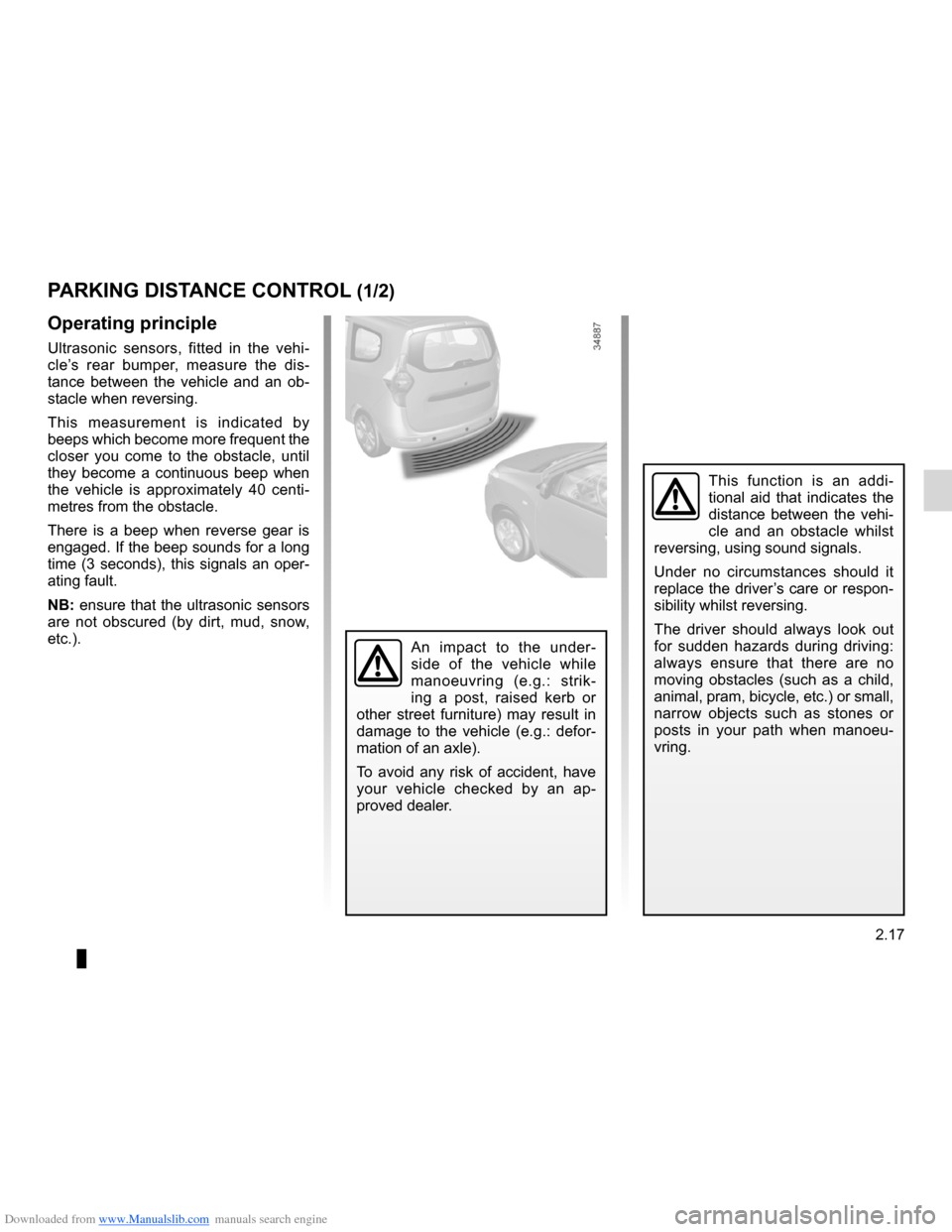
Downloaded from www.Manualslib.com manuals search engine parking distance control........................(up to the end of the DU)
driving ................................................... (up to the end of the DU)
reversing sensor ................................... (up to the end of the DU)
2.17
ENG_UD28035_2
Aide au parking (X92 - Renault)
ENG_NU_975-3_X92_Dacia_2
Parking distance control
This function is an addi -
tional aid that indicates the
distance between the vehi -
cle and an obstacle whilst
reversing, using sound signals.
Under no circumstances should it
replace the driver’s care or respon-
sibility whilst reversing.
The driver should always look out
for sudden hazards during driving:
always ensure that there are no
moving obstacles (such as a child,
animal, pram, bicycle, etc.) or small,
narrow objects such as stones or
posts in your path when manoeu -
vring.
Operating principle
Ultrasonic sensors, fitted in the vehi -
cle’s rear bumper, measure the dis -
tance between the vehicle and an ob -
stacle when reversing.
This measurement is indicated by
beeps which become more frequent the
closer you come to the obstacle, until
they become a continuous beep when
the vehicle is approximately 40 centi -
metres from the obstacle.
There is a beep when reverse gear is
engaged. If the beep sounds for a long
time (3 seconds), this signals an oper-
ating fault.
NB: ensure that the ultrasonic sensors
are not obscured (by dirt, mud, snow,
etc.).
PARKING DISTANCE CONTROl (1/2)
An impact to the under-
side of the vehicle while
manoeuvring (e.g.: strik -
ing a post, raised kerb or
other street furniture) may result in
damage to the vehicle (e.g.: defor -
mation of an axle).
To avoid any risk of accident, have
your vehicle checked by an ap -
proved dealer.
Page 92 of 196
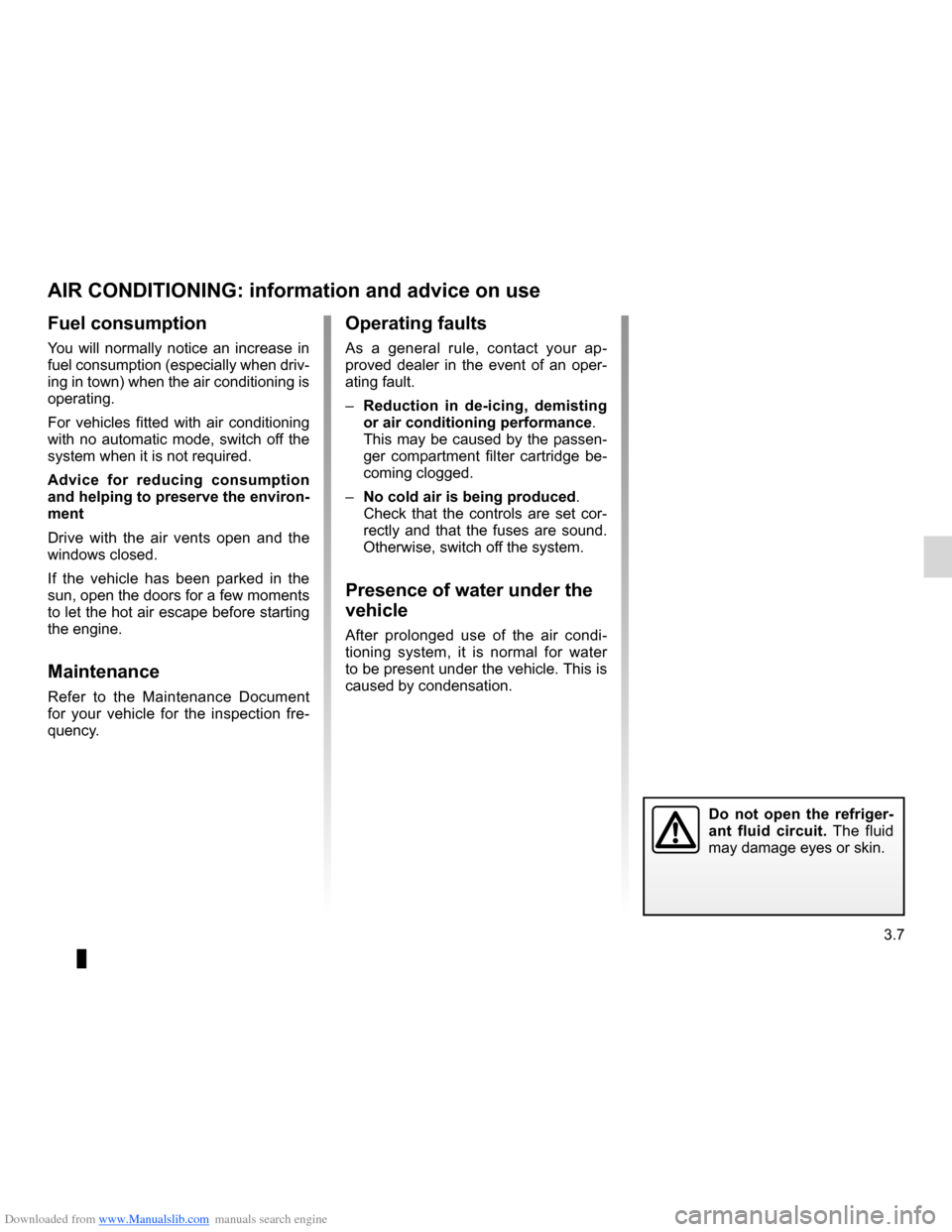
Downloaded from www.Manualslib.com manuals search engine air conditioning ..................................... (up to the end of the DU)
heating system ..................................... (up to the end of the DU)
heating and air conditioning system ..... (up to the end of the DU)
ventilation heating and air conditioning system (up to the end of the DU)
air conditioning ...................................................... (current page)
3.7
ENG_UD24441_1
Air conditionné : informations et conseils utilisation (X92 - Renaul\
t)
ENG_NU_975-3_X92_Dacia_3
Fuel consumption
You will normally notice an increase in
fuel consumption (especially when driv-
ing in town) when the air conditioning is
operating.
For vehicles fitted with air conditioning
with no automatic mode, switch off the
system when it is not required.
Advice for reducing consumption
and helping to preserve the environ-
ment
Drive with the air vents open and the
windows closed.
If the vehicle has been parked in the
sun, open the doors for a few moments
to let the hot air escape before starting
the engine.
Maintenance
Refer to the Maintenance Document
for your vehicle for the inspection fre -
quency.
Air conditioning: information and advice on use
AIR CONDITIONING: information and advice on use
Operating faults
As a general rule, contact your ap -
proved dealer in the event of an oper-
ating fault.
– Reduction in de-icing, demisting
or air conditioning performance .
This may be caused by the passen-
ger compartment filter cartridge be -
coming clogged.
– No cold air is being produced .
Check that the controls are set cor-
rectly and that the fuses are sound.
Otherwise, switch off the system.
Presence of water under the
vehicle
After prolonged use of the air condi -
tioning system, it is normal for water
to be present under the vehicle. This is
caused by condensation.
Do not open the refriger -
ant fluid circuit. The fluid
may damage eyes or skin.
Page 93 of 196
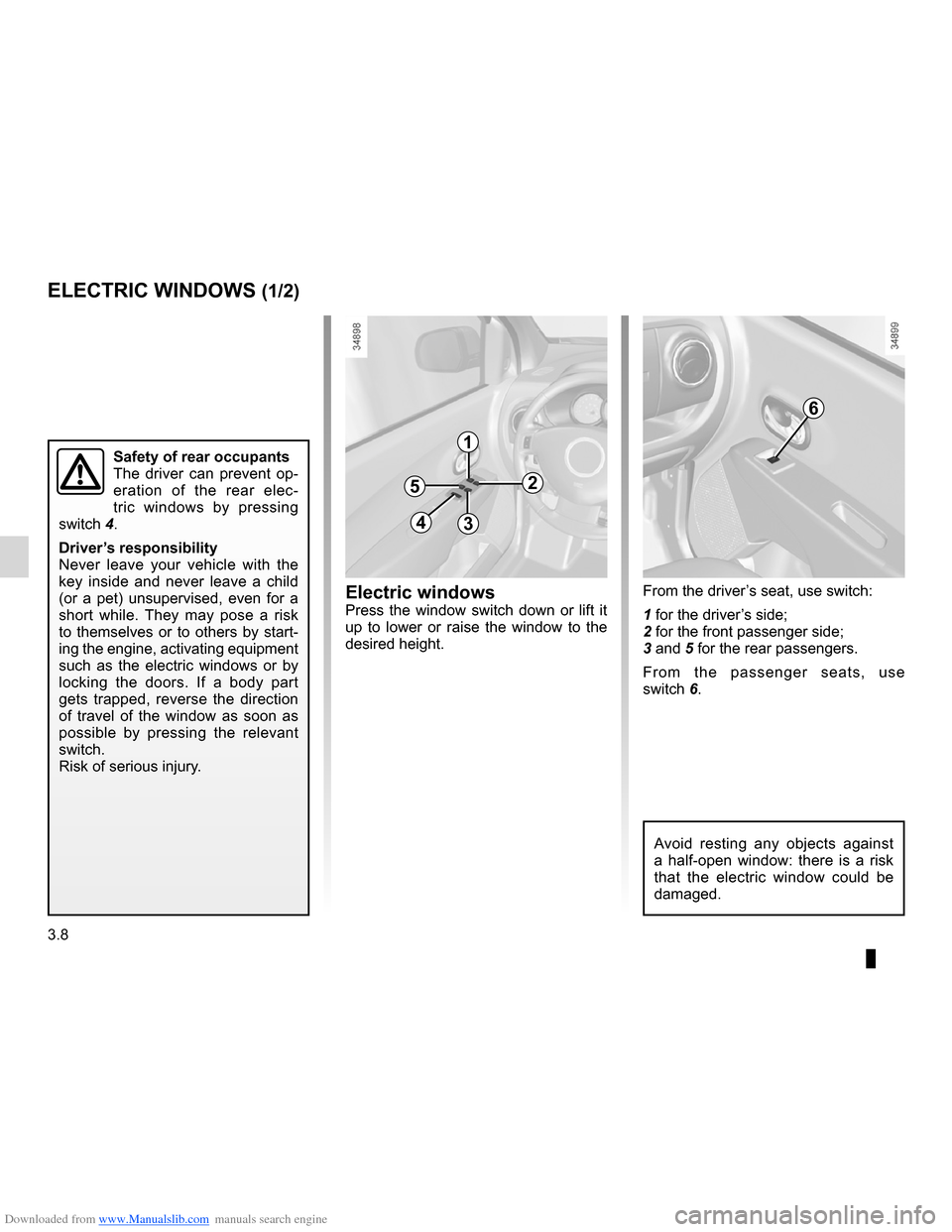
Downloaded from www.Manualslib.com manuals search engine electric windows ................................... (up to the end of the DU)
windows ................................................ (up to the end of the DU)
3.8
ENG_UD24442_1
Vitres (X92 - Renault)
ENG_NU_975-3_X92_Dacia_3
Jaune NoirNoir texte
Electric windows
ELECTRIC WINDOWS (1/2)
Safety of rear occupants
The driver can prevent op -
eration of the rear elec -
tric windows by pressing
switch 4.
Driver’s responsibility
Never leave your vehicle with the
key inside and never leave a child
(or a pet) unsupervised, even for a
short while. They may pose a risk
to themselves or to others by start-
ing the engine, activating equipment
such as the electric windows or by
locking the doors. If a body part
gets trapped, reverse the direction
of travel of the window as soon as
possible by pressing the relevant
switch.
Risk of serious injury.1
2
4
5
3
Electric windowsPress the window switch down or lift it
up to lower or raise the window to the
desired height. From the driver’s seat, use switch:
1 for the driver’s side;
2 for the front passenger side;
3 and 5 for the rear passengers.
From the passenger seats, use
switch 6.
6
Avoid resting any objects against
a half-open window: there is a risk
that the electric window could be
damaged.
Page 118 of 196

Downloaded from www.Manualslib.com manuals search engine luggage compartment cover ................. (up to the end of the DU)
3.33
ENG_UD24452_1
Cache-bagages (X92 - Renault)
ENG_NU_975-3_X92_Dacia_3
Luggage cover
LUGGAGE COMPARTMENT COVER
How to remove the luggage
compartment cover A
Using handle 1, pull it gently to release
the pins from their mounting points lo -
cated on each side of the luggage com-
partment.
Guide the luggage cover using han -
dles 1.
Removing the luggage
compartment cover
Push the luggage cover to the right
(movement B) and lift the left-hand side
of the inertia reel.
Refitting the luggage
compartment cover
Insert the right-hand side, then push it
to the right and lower the left-hand side
of the inertia reel into its housing.Do not place any objects,
especially heavy or solid
objects on the luggage
compartment cover. These
may pose a risk to the vehicle occu-
pants if the driver has to brake sud-
denly or if the vehicle is involved in
an accident.
AB
1
No person or animal should
be on the third row rear
seats if the luggage com -
partment cover is not re -
moved.